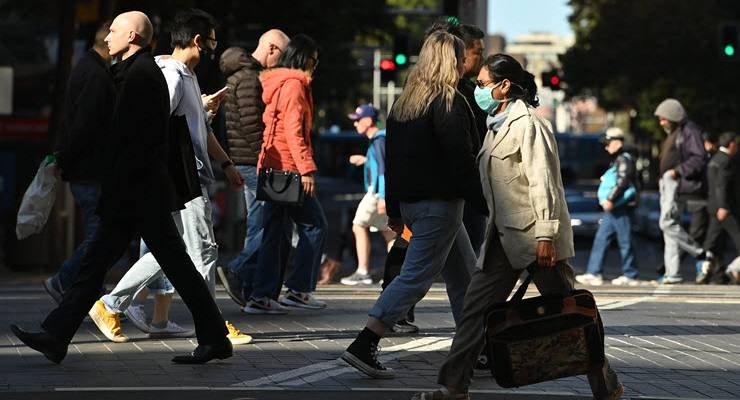
The Reserve Bank of Australia’s (RBA) rate hike cycle is turning out to be barely a barnacle on the great leviathan that is the Australian labour market. Unemployment has barely budged even as the central bankers do all they can to cool the economy. The unemployment rate still sits at 3.5% — seasonally adjusted — with companies desperate to add full-time workers.
As the next chart shows, that rate of 3.5% is only scarcely above the record low of 3.4%.
The RBA has indicated it will be paying close attention to the labour market to inform choices over future rate hikes.
Mortgage holders could be forgiven a sigh of despair that the labour market is proving so resilient. Job-seekers’ gains are mortgage holders’ losses: another 0.25% hike in rates at the RBA’s May meeting is likely, and banks will probably pass that on, meaning household budgets will be under even more pressure.
So what is going on? Usually, higher interest rates would stop firms from hiring. This is part of the theory of how monetary policy works — slower spending from customers and higher interest payments on any debt are supposed to send shivers of fear through business owners, enticing them to slow down expansion plans, stop hiring and maybe even cut staff. That should lengthen the unemployment queues, further stop people from spending, and reduce the ability of businesses to raise prices. That’s how interest rates are meant to beat inflation.
But the theory is only useful when it works. And for now, businesses are adding workers enthusiastically despite the headwinds. What is particularly impressive is that hiring is keeping up with a migration program that is bringing in workers at a record rate. The unemployment-to-population ratio is steady at 64.4%, only just below the highest level in recorded history, which was 64.5% in November last year.
It’s a beautiful set of numbers, really, because a tight labour market is a powerful force for spreading well-being into corners where it doesn’t usually reside. Youth unemployment is down enormously, underemployment is at record lows, female labour force participation is at record highs and long-term unemployment is drying up. They don’t publish unemployment rates specifically for Indigenous peoples, but I suspect they’d be falling too — in the US, Black labour force participation rates are now higher than for white workers.
A tight labour market is, in short, a powerful progressive force.
If you were going looking for a place where there could be a slight sign of deterioration, it would be in NSW, where the participation rate and the employment-to-population ratio fell slightly. That is also the state where house prices have fallen furthest, so perhaps rate hikes are gaining some traction there. On the other hand, it is also the state with by far the lowest unemployment rate — just 3.2%. Holding the unemployment rate that low for a long time is unlikely.
The dream scenario for the economy is the labour market holds its strength even as the inflation rate falls. It’s not what should happen, in theory, but as we’ve seen, sometimes economic theory doesn’t explain reality. We can hope!








This RBA is incredible. Not only are they gas-lighting unions and workers, but they are also now gaslighting jobseekers, employees (specifically), consumers and households. How much of workers’ pay packets can we take away? Interest rate rises of this magnitude would have killed inflation under previous times, pre-COVID. Not now. There are more forces at play. We don’t make our own cars now. Have to wait 6-18 months for a new one. Due to supply problems it seems. Don’t produce our own energy and fuel. Even if we did we have world parity pricing to ensure our suppliers can keep gouging us to we bleed some more. RBA can solve supply chain problems due to COVID and war between Russia and Ukraine. Won’t even begin to address the issue of our companies gouging us and raising their prices, increasing their profits, because it can’t and if it did address these profit gouging concerns, that would be an admission of its limitations and even powerlessness.
“Job-seekers’ gains are mortgage holders’ losses: another 0.25% hike in rates at the RBA’s May meeting is likely, and banks will probably pass that on, meaning household budgets will be under even more pressure.”
Mate job seekers losses will be mortgage holders’ losses to the power of 2 or 3. Once unemployment goes up, meaning some of these mortgage holders will lose their jobs and be making payments on Jobseeker, there will be less money to spend in the economy and the whole s-show that was the 1990s will repeat itself. If the jobless rate rises and interest rates stay as they are or go up much further, the economy will go into prolonged recession.
Put simply, the Reserve Bank’s models are manifestly inadequate to analyse let alone combat the problems the economy has been facing over the last 3 years at least. They cannot counter the rise in oil prices worldwide by the oil producing countries raising their prices. Killing people’s incomes here won’t stop what happens overseas, particularly in the oil producing and pricing department. There were and to an extent still are supply chain constraints, even for production inputs like car parts, solar panels, technology and building products. RBA can’t fix this. RBA can’t fix the local pricing of our energy suppliers who have and are jacking up the price of gas and electricity to onerous burdensome levels. Bad luck if you run a shop making hot food. Bad luck if you are a household. Other non-resource companies have also increased their prices, not to the same extent though. The RBA can’t stop profit gouging and supply side problems. It can only address demand side issues and it does so with a blunt instrument. By increasing the costs of borrowing to take money out of the economy which has all sorts of perverse consequences. Unemployment and business/household bankruptcy and mortgage default being the main ones.
The RBA is trying hard to kill inflation but it doesn’t have the right tools for the job.
I think it is trying to preserve the A$. Otherwise all international money investors will by 2 or 10 year US Treasury bonds. Otherwise our imports will cost more. Better hope China keeps buying our industrial coal and iron ore. We’ll be rooned otherwise. Take my advice, I saw it happen twice in my lifetime. A recession when I was an adult (excluding this last Freudenberg-induced recession). They are not nice. People lose their jobs. It’s all over once that happens. We don’t want to see unemployment go up. Once jobs are lost, so is hope. And the only people that will win will be the disaster capitalists though as there are enough wealthy people to compete in the property market or any market now there may be an avoidance of the fire sale of houses that occurred throughout the ’90s.
Unemployment also kills people through deaths of despair.
“The dream scenario for the economy is the labour market holds its strength even as the inflation rate falls. It’s not what should happen, in theory, but as we’ve seen, sometimes economic theory doesn’t explain reality. We can hope!”
No buddy. The dream scenario is for substantial and far reaching wage rises which have been denied to us for the last decade. Forget a low unemployment rate. It is the wage rate that needs strengthening. Too much has gone into profits in the last 10 years. It is long overdue to put a large part of that back into the pockets of workers.
Goodness! It’s almost as if issues caused at the supplier end of the market can’t be fixed in the short term by repeatedly bashing away at the demand end. Like employers making record profits aren’t immediately suffering when interest rate rises affect their workers. That’s the problem with the RBA’s wilful blindness as to the causes of current inflation. They have no lever to reduce the profits responsible for the increase and so have no other option but to ignore it and pretend that raising interest rates is still the right tool for the job.
Of course, if they keep it up long enough they’ll be proven right in the end. Once sufficient numbers of workers lose their houses and end up living in their cars (assuming that they can keep up the payments on their cars…) demand will drop so hard that suppliers will be forced to freeze or drop prices.
Wages must be through the roof then, right ?